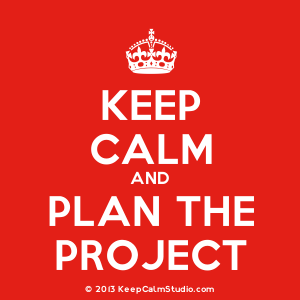I work in the marketing team of a newspaper, last year the chief editor came up with an idea to launch a new magazine which will be handling the formula one news along with drag racing and other motor racing news. Since we didn’t have any project management team in our newspaper; we were given the responsibility to manage this project.
None of our team had any idea on how to manage a project, so we wrote down some tasks and we wrote the plan and assigned responsibilities. Our plan was exactly as follows:
1- get the written content (journalism department)
2- get the advertisements and produce the magazine (marketing Department)
3- Print the magazine (the magazine was going to be printed in house).

we faced a lot of problems while implementing the project but our worst problem is that the Magazine size was supposed to be 28cm x 28cm but it was changed to 20cm x 20cm in the last minute because it wouldn’t fit in the newspaper box to be distributed along with the newspaper so we had to reduce the size of our magazine design in the last three days before the issue. We managed to do it but the magazine came out with a lot of mistakes like some of the pictures came out to be a low resolution pictures due to the last minute size change, advertisements had the writing on them too small. This caused a bad reputation about the magazine. The magazine was published twice and it was shut down due to low readership and bad reputation. This made me think of how could we have made it better as a project and avoided this failure?

After taking the MGT 598 Class I realized the answer to my question, which was: Plan your project or get Planned by it! We should have had the tasks broken to a more detailed tasks and form a work breakdown structure while assigning responsibly to each task. By determining our deliverables then dividing them to smaller deliverables and assigning responsibilities to them, and scheduling them on a gantt chart , while communicating the plan to the employees.
We also should have done a risk management plan and have a contingency plan ready to be initiated once we face any obstacles. By brainstorming and listing the possible risks then going through them identifying the implications of each of them and then rank them based on which is most probably going to happen, then we should have had a contingency plan by choosing weather if we want to mitigate, transfer, avoid or accept this risk.

I am now training my teammates to use Microsoft project in their free time, so whenever we do a project like the racing magazine or a supplement, we can use Microsoft projects to better organize our project. I been hearing rumors at our organization, that there will be a new magazine project which will be about tourism in Bahrain and outside Bahrain. Do you think that the tourism magazine will be successful?
Many companies don’t have a dedicated project management office and when new projects arise existing staff have to take on the extra work. It’s clear in your example that taking on the extra work is further further complicated by the fact no one had any training in project management. It’s great to see that you can take the learning from the class and share it with your teammates. My company had a similar experience and after several project failures decided to create a dedicated PMO. That decision has nmade a significant difference in the effectivness of our projects.
When it comes to project planning and management, details not only matter, they are often connected. In the example given, the size of the magazine was connected to the newspaper box; this connected could have been discovered in the planning phase if a flow chart was created to identify dependencies. Contingency planning should be part of any project plan. Identifying the “what ifs” that can cause problems will save time, effort and money. Project management software may facilitate the planning process, but still requires critical thinking by those creating the plan to be effective. It, in and of itself, will not create a robust plan.
Rough experience but what a great lesson learned about planning! I’ll bet everyone involved on that project is much more astute about project planning and is way more focused on details now. It’s a shame you had to learn it out in the field with a failed project but I sure the lessons stick more.
My company has two project management teams one that works will all departments (change management) and another that is housed in our tech department (Project Cafe). Many major and recent projects undertaken have been tech based. On the tech based projects the PM stays with the group until completion and sees the project all the way through. The other office, Change Management, normally surveys the situations, presents a write up and then suggests steps to follow but then backs away and leaves it to the effected group to see through. It is amazing the difference of results between the two. Needless to say, having a PM from start to finish makes ALL the difference!!!
Thanks for sharing your experience with no PM!